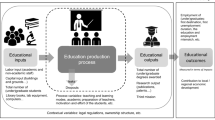Abstract
Stochastic frontier analysis is used to estimate operating cost inefficiencies of public and private non-profit universities in the U.S. while also accounting for the possible effects arising from differences in the degree of government ownership. Using panel data for four academic years, 2005–2009, inefficiencies are estimated under two model specifications. Results indicate that public universities are more cost efficient when environmental factors influence cost frontiers but private universities are the cost efficient institutions when those factors are determinants of inefficiency. Increased government funding does matter and increases private sector inefficiency but offers some efficiency improvements among public universities. Following the global financial crisis, there is evidence indicating a considerable slowdown in the inefficiency growth among both public and private universities.
Similar content being viewed by others
Notes
Outside of education, empirical applications of stochastic frontier analysis is not new. Production frontiers and efficiencies have been estimated, e.g., for the U.S. primary metals industry (Aigner et al. 1977), U.S. dairies (Kumbhakar et al. 1991), India paddy farms (Battese and Coelli 1992 and 1995), international airlines (Coelli et al. 1999), and U.S. electricity (Knittel 2002). Cost frontier research has been applied, e.g., to the U.S. airlines industry (Kumbhakar 1991), insurance industry (Cummins and Weiss 1993), hospital care (Bradford et al. 2001), banking (Huang and Wang 2001), crime prevention (Barros and Alves 2005), and English football (Barros and Leach 2007).
Evaluations of the translog produced estimates whereby more than half of the coefficients failed to meet any reasonable level of statistical significance and output and wage variables carried large negative cost effects that raised additional doubts concerning the appropriateness of the specification. Moreover, in one translog model scenario it was not possible to achieve convergence. In another model scenario, the likelihood ratio test could not reject the Cobb-Douglas over the translog.
Chow tests on the OLS estimates produced statistically significant F values that confirmed structural differences in the public and private sectors: F(6, 2204) = 20.82 and F(9,2200) = 33.23 with and without environmental factors, respectively. Following the cost frontier implementations, structural differences were again confirmed: with 16 df, χ2 = 51 and 39 with and without environmental factors, respectively. The conclusion of structural differences supports previous findings (e.g., beginning with Cohn et al. (1989) and subsequently Koshal and Koshal (1999), Sav (2004), and Lenton (2008), among others).
References
Abbott, M., & Doucouliagos, C. (2009). Competition and efficiency: overseas students and technical efficiency in Australian and New Zealand universities. Education Economics, 17, 31–57.
Aigner, D. J., Lowell, C. A. K., & Schmidt, P. (1977). Formulation and estimation of stochastic frontier production function models. Journal of Econometrics, 6, 21–37.
Barros, C. P., & Alves, F. P. (2005). Efficiency in crime prevention. International Advances in Economic Research, 11, 315–328.
Barros, C. P., & Leach, S. (2007). Technical efficiency in the English Football Association Premier League with stochastic cost frontier. Applied Economics Letters, 14, 731–741.
Battese, G. E., & Coelli, T. J. (1992). Frontier production functions, technical efficiency and panel data: with application to paddy farmers in India. Journal of Productivity Analysis, 3, 153–169.
Battese, G. E., & Coelli, T. J. (1995). A model for technical inefficiency effects in a stochastic frontier production function for panel data. Empirical Economics, 20, 325–332.
Battese, G. E., & Corra, G. S. (1977). Estimation of production frontier model: with application to the pastoral zone of Eastern Australia. Australian Journal of Agricultural Economics, 21, 169–179.
Bradford, W. D., Kleit, A. N., Krousel-Wood, M. A., & Re, R. N. (2001). Stochastic frontier estimation of cost models within the hospital. The Review of Economics and Statistics, 83, 302–309.
Chakraborty, K., & Poggio, J. (2008). Efficiency and equity in school funding: a case study for Kansas. International Advances in Economic Research, 14, 228–241.
Coelli, T., Perelman, S., & Romano, E. (1999). Accounting for environmental influences in stochastic frontier models: with application to international airlines. Journal of Productivity Analysis, 11, 251–273.
Cohn, E., Rhine, S. L. W., & Santos, M. C. (1989). Institutions of higher education as multi-product firms: economies of scale and scope. Review of Economics and Statistics, 71, 284–290.
Cummins, J., & Weiss, M. A. (1993). Measuring cost efficiency in the property-liability insurance industry. Journal of Banking and Finance, 17, 463–481.
Huang, T., & Wang, M. (2001). Measuring scale and scope economies in multiproduct banking? A stochastic frontier cost function approach. Applied Economics Letters, 8, 159–162.
Knittel, C. R. (2002). Alternative regulatory methods and firm efficiency: stochastic frontier evidence from the U.S. electricity industry. The Review of Economics and Statistics, 84, 530–540.
Koshal, R., & Koshal, M. (1999). Economies of scale and scope in higher education: a case of comprehensive universities. Economics of Education Review, 18, 269–277.
Kumbhakar, S. C. (1991). The measurement and decomposition of cost-inefficiency: The Translog Cost System. Oxford Economic Papers, 43, 667–683.
Kumbhakar, K., Ghosh, S., & McGuckin, J. T. (1991). A generalized production frontier approach for estimating determinants of inefficiency in US dairy farms. Journal of Business and Economic Statistics, 9, 279–286.
Lenton, P. (2008). The cost structure of higher education in further education colleges in England. Eonomomics of Education Review, 27, 471–482.
McMillan, M. L., & Chan, W. H. (2006). University efficiency: a comparison and consolidation of results from stochastic and non-stochastic methods. Education Economics, 14, 1–30.
Sav, G. T. (2004). Higher education costs and scale and scope economies. Applied Economics, 36, 607–614.
Stevens, P. A. (2005). A stochastic frontier analysis of English and Welsh universities. Education Economics, 13, 355–374.
Author information
Authors and Affiliations
Corresponding author
Rights and permissions
About this article
Cite this article
Sav, G.T. Stochastic Cost Frontier and Inefficiency Estimates of Public and Private Universities: Does Government Matter?. Int Adv Econ Res 18, 187–198 (2012). https://doi.org/10.1007/s11294-012-9353-4
Published:
Issue Date:
DOI: https://doi.org/10.1007/s11294-012-9353-4




